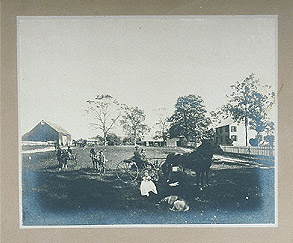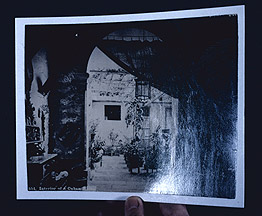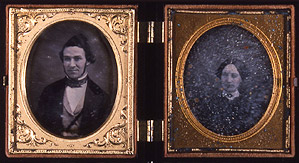
photographic prints
1 Photographic Prints: Black and White | 2 Photographic Prints: Color/Digital
1 Photographic Prints: Black and White
Among the materials collected by cultural institutions, photographs are often the most treasured and heavily used. Extensive technical and aesthetic changes have affected photography since 1839, when Louis Daguerre developed a practical method for creating permanent images.
Each photographic process has unique characteristics that affect its deterioration, storage, and handling. In order to care properly for photographic collections, you must understand how photographs are made and learn how to identify their various types. You must also become familiar with problems related to their physical and chemical composition.
The Basic Photographic Process
Photographs are composite objects, consisting of a base (also called a support), a binder, and an image-forming substance. To produce a photographic image, light-sensitive materials such as silver salts are applied to a support made of paper, cloth, plastic, or metal, and exposed to light. This forms either a direct visible image (known as printing out) or a latent image, which can be developed using a chemical developer (known as developing out). The image is "fixed" in order to remove excess light-sensitive material and stop the darkening process. It is then washed to remove residual fixer.
Image-Forming Materials
As photographic techniques developed, a number of different light-sensitive materials were used to form the image. The most important was metallic silver, which was used in most 19th century photographic prints (including salted paper prints and albumen prints) and is still used in modern black and white prints. Differences in appearance in the different types of prints are due to differences in the physical form of the silver particles.
Several other image-forming materials were used as different processes developed through the 19th century. Platinum was used to create paltinotypes, which are silver-gray in color and quite stable. Iron slats, used to create cyanotypes, are far less stable, which causes the prints to fade when exposed to light or alkaline materials. Carbon prints, woodburytypes, and gum bichromate prints all use inorganic pigments, and have excellent stability. Dyes were often used for hand coloring, or to tint layers of the image or support, and often become very unstable as they age.
Silver images exhibit several characteristic types of deterioration:
Sulfiding—This is the formation of silver sulfide when silver reacts with sources of sulphur. This can result from the presence of sulphur in the atmosphere, but it is most often due to inadequate processing that leaves behind residual processing chemicals (fixers) in the print. The result is yellowing, staining, and fading of the image, usually beginning with the highlights.
|
|
Redox—The visual results of redox reactions vary depending on the type of image, but generally they include loss of highlight detail, fading, and change of image color to reddish, yellow, or yellow-brown. Silver mirroring (formation of a bluish metallic sheen on the surface of the image) is also a result of oxidation-reduction, and is particularly characteristic of silver images suspended in a gelatin binder.
Binders
Various materials have been used as binders (in which the image-forming material is suspended) for photographic prints. Albumen (egg white) tends toward chemical reactions that cause it to yellow over time, which is exacerbated by the presence of residual fixative and mounting on poor-quality board. Albumen also becomes brittle and subject to cracking. Collodion (cellulose nitrate) is not flexible and becomes brittle, leading to cracks in the emulsion, but otherwise is fairly chemically stable and does not yellow. Gum arabic was used as a binder for gum bichromate prints, which are stable but rare because they were difficult to produce. Gelatin, the most common binder material, is made from animal proteins. It is fairly stable chemically but is quite sensitive to moisture in the air.
Supports
|
|
Nineteenth century prints generally had a primary support of high quality stable paper, although the secondary support was often poor quality (usually board was used for very thin prints, such as albumen prints). In the later 19th century, the primary paper support was often coated with barium sulfate in gelatin (or in collodion, for collodion printing-out paper); this was known as the baryta layer. This layer was very stable, protected the paper from light damage, and provided some protection against damaging substances from poor-quality secondary supports.
Resin-coated (actually polyethylene-coated) paper was introduced as a support for photographic prints during World War II and became commercially available during the 1970s. This type of paper shortened photographic processing time because it required less washing and it was sturdy, allowing processing to be completely mechanized. Most modern color prints are printed on resin-coated paper, which consists of a paper base between two layers of polyethylene, with titanium dioxide added to the emulsion-side layer.
Many early prints on resin-coated paper that were framed and exhibited developed cracking of the emulsion layer over time. Some black and white resin-coated prints on exhibit also developed redox, yellowing, and silver mirroring. These problems were due to the titanium dioxide in the emulsion (which facilitated the formation of an oxidizing agent on exposure to light), and they occurred most commonly in framed photographs where the oxidizing agent could not dissipate. Stabilizers and antioxidants were added to later resin-coated papers during manufacturing to combat this type of deterioration, but this does not completely eliminate the risk of damage.
Daguerreotypes, Ambrotypes, and Tintypes
|
|
These formats are positive images captured on non-paper supports. Daguerreotypes, positive images on thin copper plate with a silver coating, were popular between 1840 and 1860. They are usually found in small hinged cases and are quite fragile and subject to tarnishing due to exposure to pollutants. Ambrotypes (popular in the late 1850s) and tintypes (produced throughout the late 19th century) are both silver images in a collodion binder, but ambrotypes have a glass support sometimes coated with paint or lacquer, while tintypes have a thin lacquered iron support. Ambrotypes sometimes suffer chips in their original coating material. Tintypes are easily bent, sometimes causing the emulsion to crack.
James M. Reilly's Care and Identification of 19th Century Photographic Prints, (see Additional Resources) provides more information on why prints deteriorate and how to identify photographic processes.
2 Photographic Prints: Color/Digital
The primary difference between black and white and color prints is in the image-forming material. There are two types of color photography: chromogenic and nonchromogenic. Modern chromogenic color photographs are the most common and use organic cyan, magenta, and yellow dyes as the image-forming material. The chromogenic process (introduced in 1935) forms a black and white silver image, which causes the developing chemical to react with dye couplers to form a dye image around the black and white image. The black and white image is then removed with bleaches and the color image is fixed and washed.
A different type of dye (azo dye, which is much more stable) is used in nonchromogenic photography (e.g., Cibachrome and Ilfachrome), which was introduced in 1955. This process is known as silver dye bleach and produces photographs with excellent dark stability and better light stability than chromogenic photographs. However, chromogenic materials are cheaper and more versatile, and thus much more common.
Deterioration of Chromogenic Color Prints
|
Dye fading is common in |
Dye fading—Unfortunately, the dyes used in chromogenic processing are inherently unstable. The three dyes fade at different rates, so there is often an imbalance of color in deteriorated color photographs (e.g., the cyan dye fades first, leaving the photograph with a reddish tinge). It is also very important to note that some dyes that fade faster in the light may be more stable in the dark, and vice versa. In general, early color photographs were very unstable; many lost 30% of their dyes (30% loss is the accepted point at which deterioration becomes evident) within 10 to 15 years. Even color photographs from the 1980s will reach the 30% mark within 20 years. Advances in dye stability were made during the 1980s and 1990s, and contemporary color materials can be expected to survive 30 to 50 years at room temperature.
Highlight staining—This appears as a yellowish staining in the highlight areas of the photograph, and is due to residual dye couplers for the magenta dye, which form these stains as they decompose.
Digital Color Prints
The increase in digital photography in the last decade means that many photographs are now printed on photo printers rather than processed in the traditional way. These prints are created using dyes and inks, some of which are not stable or long lasting. Waterproof pigment-based inks are more stable than dye-based water sensitive inks, but they usually have a smaller range of color. Many types of paper supports are also used, including laser/copying paper, general purpose inkjet paper, fine art papers, and coated inkjet papers (which have a special coating to help them receive the inks).
Ultimately, using the right combination of paper, printer, and ink is most crucial to digital print longevity. Wilhelm Imaging Research (founded by Henry Wilhelm, an expert in the field of color photographic materials) has tested many papers, inks, and printers on the market today. In addition to providing guidance on the life expectancies of various digital prints, these tests have shown that using third party inks and paper will not provide the same durability as using ink and paper recommended by the printer manufacturer. See the NEDCC Preservation Leaflet Creating Long-Lasting Inkjet Prints for more detailed information.




